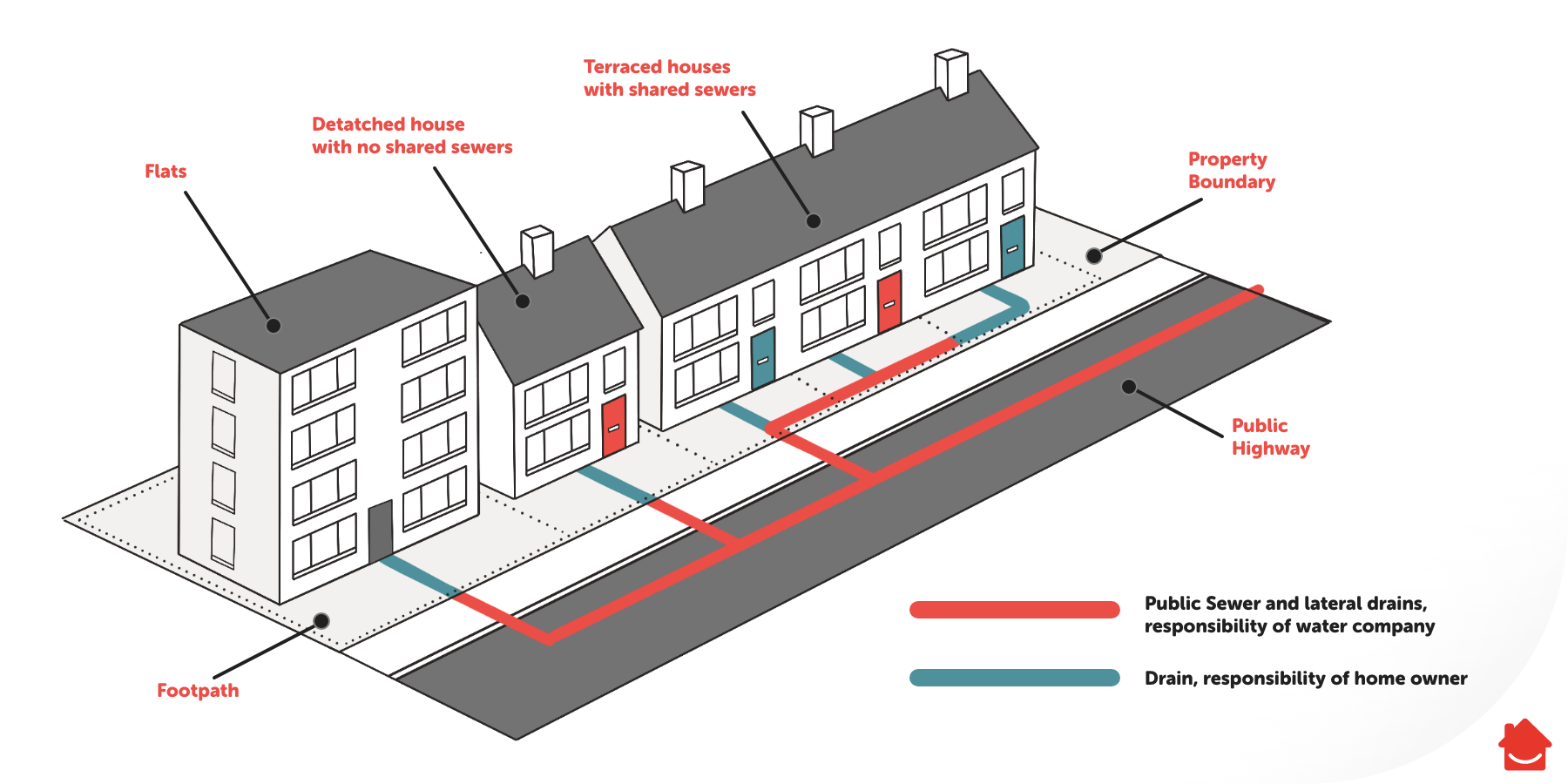If there’s a funny smell just outside your home, or your sink is taking ages to drain, you may be dealing with a blocked drain. But don’t worry – nine times out of ten you’ll be able to unblock it yourself and probably won’t need to call anyone out.
This article will take you through the common types of drain blockages outside and inside your home, the reasons why they occur, and how to avoid them and who can help you fix problems should they arise.
Common types of outside drain blockages
Let’s talk about the common types of drain blockages outside your home. There are a few factors that can help you work out if the blockage originated within your home or is a bigger problem affecting your shared drains.
First, talk to your neighbours and ask them if they have any issues with water draining at their house. If they’re not experiencing any trouble, or your inside drain’s blocked but your external drain is fine, then it’s solely your responsibility.
If you notice any of the below, it’s important to take action as soon as you can:
- Blocked external drain
It can be blocked with leaves and debris from outside the house, or from inside with coffee grounds or sanitary items. This may not just be your responsibility. - Blocked outside kitchen drain
A blocked outside kitchen drain is not part of the public sewer, so it’s your responsibility to clear it. Keep reading for advice on what to do. - Smelly drains outside
The rotten smell is the giveaway – investigate further and you might find all manner of items blocking your drains. - Outside drain overflowing
Again, if your drain is overflowing, it’s a telltale sign of a blockage. Keep reading for advice on what to do.
What causes blocked outside drains?
It’s important to keep your outside drains healthy and avoid common mistakes that could lead to major headaches.
The usual suspects for blockages in outside drains are:
- Leaves and branches
- Soil and mud
- Moss
- Litter
- Other outdoor debris
Items you pour or flush down your pipes inside the house can also be just as (if not more) problematic. These might include:
- Pouring fat, oil or coffee grounds down the sink
- Flushing wet wipes and sanitary items down the toilet
- Leaving hair and soap to build up in your shower
You should take steps to fix these issues, and consider preventative measures like drain covers, to protect yourself from blockages in the future. And do check out local water partners, such as Anglian Water, Yorkshire Water and Severn Trent for HomeServe Insurance, for help and support in the event of a blockage.
Top tip to prevent future blockages: Keep your outside drains clean and clear with a quick blast from a pressure hose every once in a while.
Who is responsible for blocked drains outside?
The responsibility for blocked drains depends on how the drainage network operates in your area.
In the early 2010s, the UK government changed legislation in many areas of the country, transferring the responsibility for private sewers and lateral drains to water sewerage companies. This meant clear ownership and better long-term maintenance of the sewer network.
Take a look at the diagram to see the various cases for the different types of properties.

The long and short of it is that trusted water partners like Anglian Water, Yorkshire Water, Severn Trent, and others are on hand if the blockage you’ve found is affecting a public drain. If it’s not a public drain, it’s up to you to fix it – or get someone else in to do so.
How do I know if my drain is shared?
It’s vital to contact your local water company if your outside drains are shared, as the source of the blockage may be from another property and your own DIY fixes will not clear the issue in the long term.
To find out if your outside drains are shared, contact your water sewerage company. You can also check the deeds of your property or give your local authority a call.
How to unblock a drain outside
There are steps you can take to fix an external blocked drain yourself, as long as it’s a fairly minor issue and it’s not a shared drain. If you’re at all in doubt, get in touch with a professional plumber or drainage expert. They’ll have the tools to unblock the drain quickly and efficiently. Don’t attempt anything you’re not sure about.
First, you need to work out where the blockage is and therefore who is responsible for unblocking it.
- Contact your local water sewerage company so they can advise on whether you are responsible. They will come out to unblock the drain if appropriate
- Follow the DIY fix guide below if it’s a blockage you are responsible for as the property owner, and you’re looking for a quick fix.
Keep yourself covered with our plumbing and drainage cover. If a blockage affects your home and it’s your responsibility to sort it, our cover means you’ll be able to call on our trusted Home Experts to help you.
Blocked drain outside: DIY fix
There are steps you can take to fix an external blocked drain yourself, as long as it’s a fairly minor issue and it’s not a shared drain. If you’re at all in doubt, call a professional plumber or drainage expert who will have the tools to unblock the drain quickly and efficiently. Don’t attempt anything you’re not sure about.
Preparation
You’ll need a few items for the job:
- Rubber gloves
- Protective clothing. Goggles might be wise.
- Drain rod (a bigger version of a plumber’s auger)
- Bucket/bin bags
- Rubber gloves and face mask
- Appropriate tools or rope (for lifting the drain cover)
- Pressure hose (for cleaning the drain afterwards)
Steps to unblock an outside drain
With the right equipment on hand, take the following steps:
1) Get the drain cover off
You’ll need a strong flat-head screwdriver or other appropriate tools for this, depending on the cover. It’s heavy, so if it doesn’t work, in some cases you can, tie a rope around the cover to get better leverage. Remember care needs to be exercised to prevent the cover from falling down the drain.
2) Find the blockage
With your gloves on and face mask, try to remove as much of the blockage with your hands as possible. You’ll be able to clear the rest with a drain rod. Place your bucket or bin bags nearby, try not to breathe in too hard and think of all the money you’re saving by doing this yourself!
3) Use your drain rod
Insert the drain rod into the drain and twist the rod into the blockage in a clockwise direction, applying some pressure. Keep plunging and twisting – the blockage may be extremely stubborn. When it starts to feel easier, that’s your sign that the blockage is clearing.
What do I do if there’s standing water?
You’ll want to remove as much of it as you can before attempting to remove some of the blockage with your hands, but your drain hose will still work through standing water.
What should I do if I’m trying to unblock a drainpipe?
You can start by using the same methods you’d try for clearing an inside drain blockage.
- Pour boiling water down the drain
- Add a cup of bicarbonate of soda
- Now add a cup of vinegar and watch it start to fizz and froth
- Replace the drain cover loosely and let it work its magic for a few hours. Repeat until you make headway.
Protect yourself against blocked drain issues
It’s important to keep your drains clear to prevent blockages. However, if you’re having trouble HomeServe can connect you with trusted, experienced professionals who’ll help to sort things out, via our insurance or one-off repairs service.
Common questions about blocked drains outside
Who is responsible for the drains on your property?
All internal drains on your property, as well as your immediate outside kitchen drain, are the responsibility of the homeowner. If it’s an external/shared drain, you can find out whose responsibility it is by contacting your local water/sewerage company.
Who is responsible for drain covers?
If you have a drain cover inside your property boundary and it serves only your property, this is your responsibility to maintain. If it serves other properties as well, confirm ownership with the local water company. Your local water/sewerage company is responsible for lateral drains, as well as sewers.
Who is responsible for blocked road drains?
Your local authority or council is responsible for road drains, including those on country roads. As a homeowner, your responsibility for drains usually extends to the boundary of your garden or driveway.
How much does it cost to unblock an outside drain?
The cost of unblocking an outside drain depends on what type of blockage you have, how deep it is in your system and what method or equipment will be needed to unblock it. You can unblock drains yourself by following our handy guide. Professional drain cleaning can cost from £70 for drain jetting, while drain rodding ranges from £80 to £145 and a full system scrub can be up to £200.




